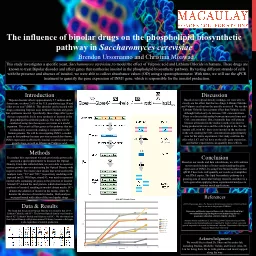

Saccharomyces cerevisiae This study investigates a specific yeast Saccharomyces cerevisiae to model the effect of Valproic acid and Lithium Chloride in humans These drugs are known to treat Bipolar disorder and affect genes that synthesize inositol in the phospholipid biosynthetic path ID: 932690
Download Presentation The PPT/PDF document "The influence of bipolar drugs on th..." is the property of its rightful owner. Permission is granted to download and print the materials on this web site for personal, non-commercial use only, and to display it on your personal computer provided you do not modify the materials and that you retain all copyright notices contained in the materials. By downloading content from our website, you accept the terms of this agreement.
Slide1
The
influence of bipolar drugs on the phospholipid biosynthetic pathway in Saccharomyces cerevisiae
This study investigates a specific yeast, Saccharomyces cerevisiae, to model the effect of Valproic acid and Lithium Chloride in humans. These drugs are known to treat Bipolar disorder and affect genes that synthesize inositol in the phospholipid biosynthetic pathway. By testing different strands of cells with the presence and absence of inositol, we were able to collect absorbance values (OD) using a spectrophotometer. With time, we will use the qPCR treatment to quantify the gene expression of INM1 gene, which is responsible for the inositol production.
ConclusionBased on our results and data calculations, we will continue our research in hopes of better understanding the gene expression of INM1, by using First Strand Synthesis and qPCR. These tests will quantify our results as it amplifies our DNA copies. The lipid biosynthetic pathway is a growing area of molecular biology research, and there is a lot to gain when applying these experimental analyses to various social applications.
MethodsTo conduct this experiment we took previously grown cells and used a spectrophotometer to measure the Optical Density. From this collected data, we were able to construct various growth curves representing the Optical Density with respect to time. Two main yeast strains that were used in this analysis were, “#3” and “#27,” respectively modeling wild type and ino2Δ. Wild type, strand #3, was used to represent normal cells containing all genes in the presence of inositol. Strand #27 deleted the ino2 protein, which deactivated the synthesis of inositol, resulting in inositol absent media. SC+ denotes the addition of inositol in the media, while SC- denotes the absence of inositol in media. Both analyses were performed with either of the two bipolar drugs.
Introduction“Bipolar disorder affects approximately 5.7 million adult Americans, or about 2.6% of the U.S. population age 18 and older every year”(DBSA). This disorder can be treated with drugs containing Valproic acid, Lithium Chloride and genes that synthesize inositol. Specifically, these drugs affect genes that are responsible for de novo synthesis of inositol in the phospholipid biosynthetic pathway. The study will be conducted using Saccharomyces cerevisiae as a model organism. This yeast cell has genes in this pathway that are evolutionarily conserved, making it comparable to the human genome. We will be investigating INM1, a model gene in this pathway because previous research has shown, INM1 expression is affected by inositol, a carbon source and growth stage, as well as lithium and Valproic acid.
References(2013). Expression atlas. The European Bioinformatics Institute, Retrieved from http://www.ebi.ac.uk/gxa/gene/YHR046CDepression and bipolar support alliance. (n.d.). Retrieved from http://www.dbsalliance.org/site/PageServer/Calendar/PageServer?pagename=education_statistics_bipolar_disorderMarlene Murray and Miriam L. Greenberg.(2000) Expression of yeast INM1 encoding inositol monophosphatase is regulated by inositol, carbon source and growth stage and is decreased by lithium and valproate. Department of Biological Sciences, Wayne State University
Data
& ResultsWe found that the greatest Optical Density was found in that of #3, Lithium Chloride, and SC+. The lowest Optical density was found in that of #27 Lithium Chloride and Valproic acid SC-. We also found out that Optical Density will plateau around 30 hours, because cells begin to die, regardless of inositol production.
Brendon Ursomanno and Christina Moawad
AcknowledgmentsWe would like to thank Dr. Shen and his entire lab, including Paulina, Michelle, Goldie, and Gracie. Also, Dr. Liu for being there for us with guidance and moral support along the way.
Discussion
Based on our optical density readings, we were able to clearly see the effect that the two drugs, Lithium Chloride and
Valporic
acid had on the specific yeast cell. We see that Lithium Chloride has a greater effect than Valproic acid; although both clearly do increase O.D. concentrations. There is a direct relationship between increased time and O.D. concentrations. But, eventually they will plateau because all inositol in the media is used, or no more is being produced de novo and the cells begin to die. For the mutant cell, with SC- there is no inositol in the media nor in the cell, making the O.D. concentrations approximately zero for the entire experiment. Our study confirms the effect that
LiCl
and Val have on the cells gene expression, and further experiments can quantify these effects.